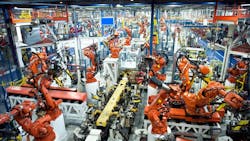Empower Your Sustainability Through Intelligent Lighting Control
LED Lighting is the most efficient white lighting on the market, offering significant energy savings and reduction in carbon emissions. With a lifespan lasting more than five times longer than legacy lighting technologies, LED lighting reduces landfill waste to further protect the environment.
However, as the industrial sector strives to embrace sustainability, a new challenge looms on the horizon. With the U.S. Securities and Exchange Commission (SEC) pushing for reporting requirements including financial impact and climate-related impact metrics, organizations in the industrial sector will need to demonstrate, report, and showcase their eco-friendly initiatives. This is where automation software becomes an important tool for industrial organizations to quickly provide reports and real-time energy usage for their facilities. By integrating LED lighting with industrial facility automation software systems, organizations can obtain quantifiable and actionable information on energy usage and carbon reduction.
Empowering Sustainability Through Intelligent Energy Management
While wireless controls have long been employed in lighting systems, their efficacy hinges on intelligent management. Occupancy sensors and daylight harvesting sensors are among the many technologies that have been available to dim or switch light fixtures on and off to save on energy usage. However, it requires intelligent controls for these sensors to provide the useful feedback industrial organizations will require. Integrating with an industrial facilities automation software, an intelligent control system can provide detailed reports on the energy usage of LED light fixtures. This granular control and system-wide visibility allows facility managers to optimize lighting grouping, dimming, and scheduling around the unique needs of their facilities to maximize energy savings. Intelligent lighting controls empower industrial organizations to manage their lighting and enables them to clearly demonstrate how that control reduces energy costs and carbon emissions.
Enhancing Operational Efficiency and Safety
Tying existing lighting to automation systems can also save time and money in production. Industrial customers can use lighting and sensors to identify issues with machines or on their production floor, such as manufacturing line jams. Being able to quickly identify issues by utilizing sensors to change the state of the lights can help dramatically improve safety and productivity.
Site Managers are able to consolidate control systems and simplify their maintenance procedures by integrating with their existing Programmable Logic Controller (PLC). Site Managers use PLCs to monitor all aspects of their facilities, from heating and cooling systems to large industrial machinery. Integrating the lighting system into the PLC makes it possible to send alerts and notifications of any maintenance needs.
Pioneering the Future of Industrial Lighting
As the Industrial Internet of Things (IIoT) continues to evolve, the convergence of smart technologies holds immense promise. Technological advances in the industrial sector will be closely tied to the useful information that can be gained from equipment installed in smart facilities. With Artificial Intelligence (AI) technology at the forefront of innovations, it’s no stretch to imagine IIoT where AI is used to predict maintenance needs and optimize a facility’s performance. Smart lighting fixtures connected to a PLC system would provide the dataset from which AI could pull information to make decisions and schedule maintenance.
Digital Twin is another emerging technology shaping the future of how facilities are managed and designed. Having data from lighting fixtures that can provide exact digital representations of their physical characteristics and performance can dynamically link the lighting to a virtual design environment.
Elevating Your Sustainability Journey
The adoption of LED light fixtures is a good step forward for any industrial organization on their journey towards sustainability. However, to fully realize the value and impact of these light fixtures, intelligent control systems used in tandem with PLC software must complement the installation. These systems not only optimize lighting investments, but also can help prepare your facility for the future. Whether it is new government regulations requiring reporting or new technologies requiring data, integrating your lighting controls with your PLC will put you at the forefront of sustainable innovation.
About the Author

Rizwan Ahmad
Chief Operating Officer – Dialight
Rizwan Ahmad is the Chief Operating Officer at Dialight, a global leader in industrial LED lighting. Rizwan has helped pioneer Dialight’s award winning LED lighting solutions to suit the complex needs of harsh and hazardous industrial environments. Prior to his 23 years at Dialight, Rizwan joined Bell Labs (Lucent Technologies) to help introduce industry and world-first VoIP technology used by AT&T, Verizon and other worldwide telecom providers, while also previously assisting with the early development of Human Vocal Tract Simulator for speech recognition and voice verification. Rizwan has both a B.S.E and M.S.E in Electrical/Electronic Engineering, specializing in areas such as Digital Signal Processing (DSP), Integrated Devices and Communication.
